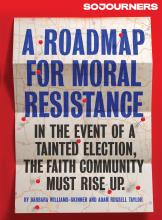EARLIER THIS YEAR, Emancipation Memorial in my neighborhood of Lincoln Park in Washington, D.C., became the target of national protests and calls for removal. Erected to great fanfare in 1876, the memorial is not a Confederate monument but an homage to Black freedom built with the hard-earned dollars of former slaves. It commemorates a sacred moment in Black history, but does so with the racist imagery—and thus fictive narrative—of Abraham Lincoln dominating a crouching, half-dressed, emancipated Black man.
I resented Emancipation Memorial each time I passed by it, but when the calls began for its removal, I faltered. Learning its history several years ago as a monument fundraised by formerly enslaved Black people forged for me feelings of connection to it, even as I recoiled at its imagery. The meaning of “home” it carried as the landmark naming my D.C. neighborhood and church intensified in light of these feelings. My complicated response led me to reflect on another structure close to home for me that has yet to be dismantled.
Read the Full Article

